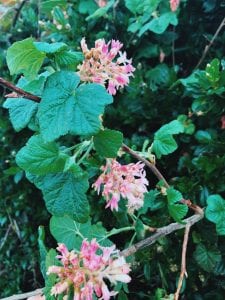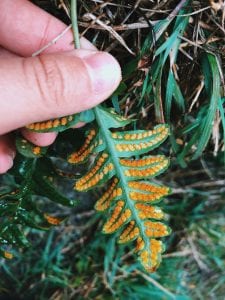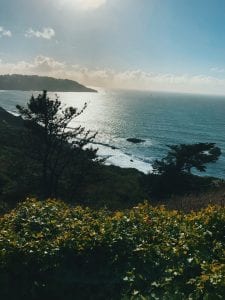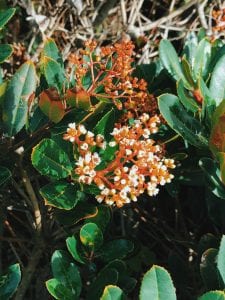February 14, 2019
Batteries to Bluff Trail, 37.7974° N, 122.4793° W
On February 14, our botany class took a short journey up to the Batteries to Bluff Trail in the Presidio. As we walked along the trail, we had a beautiful view of Marshall Beach and of the Golden Gate Bridge. This trail has been the site of recent restoration efforts that aim to remove invasive trees and plants (such as the Iceplant which we observed) and remediate the impacts of military use. Lupine, toyon, coyote brush, native dune plants, and invasive ivy (such as cape ivy) are common sights in the Batteries to Bluff Trail.
While on the trail, we observed Flowering currant (Ribes sanguineum), which belongs to the Grossulariaceae family. The flowering currant is a deciduous shrub that can be found in the western coastal regions of North America. The shrubs are usually between 6-10 feet tall. Its leaves are simple and palmately lobed with dentate margins. The leaves are alternately arranged and the bases of the leaves are chordate. The clusters of flowers are arranged in pendant, raceme inflorescences with 10-20 flowers within each cluster. The flowers themselves exhibit radial symmetry and consist of 5 fused and tubular petals as well as 5 anthers and 1 stigma.
California polypody (Polypodium californicum) is a fern belonging to the Polypodiaceae family. The California polypody is a perennial herb that is native to California but is also confined to western North America. Depending on the climate, the fern can be either evergreen or deciduous – in wetter climates, such as San Francisco, the California polypody is often evergreen. The blades are simple pinnate. The leaves of the fern are deltate-ovate and are moderately fleshy. Organized rows of yellow-orange sori can be found on the underside of the leaves.
Blueblossum (Ceanothus thyrsiflorus) belongs to the Rhamnaceae family. It is a common evergreen shrub throughout California. Generally, it prefers coastal regions and is confined to western North America. The blueblossum thrives in poor soil and prefers lighter areas but can tolerate shade. Its leaves are simple and alternately arranged. The shape of the leaves is ovate-elliptic, with acute-rounded tips. The leaves also exhibit strong venation on their underside, with three prominent veins. The margins of the leaves are minutely dentate/serrate. Additionally, the stems of the blueblossom are ribbed. Meanwhile, the flowers are blue and are arranged in raceme or panicle-like inflorescences.
Although it was supposed to rain the whole day, the sky miraculously cleared up and the sun was actually out for the majority of our trip. There were a few instances where it would begin to rain sporadically for just a few minutes before clearing up but we have to earn our stripes somehow, I guess. Despite the sun, it was still pretty chilly due to the strong winds – there were a few times where I nearly lost my papers but all ended well. Overall, besides the slightly disconcerting sight of a child’s abandoned sock, the hike was beautiful and we were able to learn about roughly 25 new plant species! We got to see the Golden Gate Bridge in the distance, as well as huge swaths of blue-green serpentine rock covering the hillside.
Honorable Mention Species














